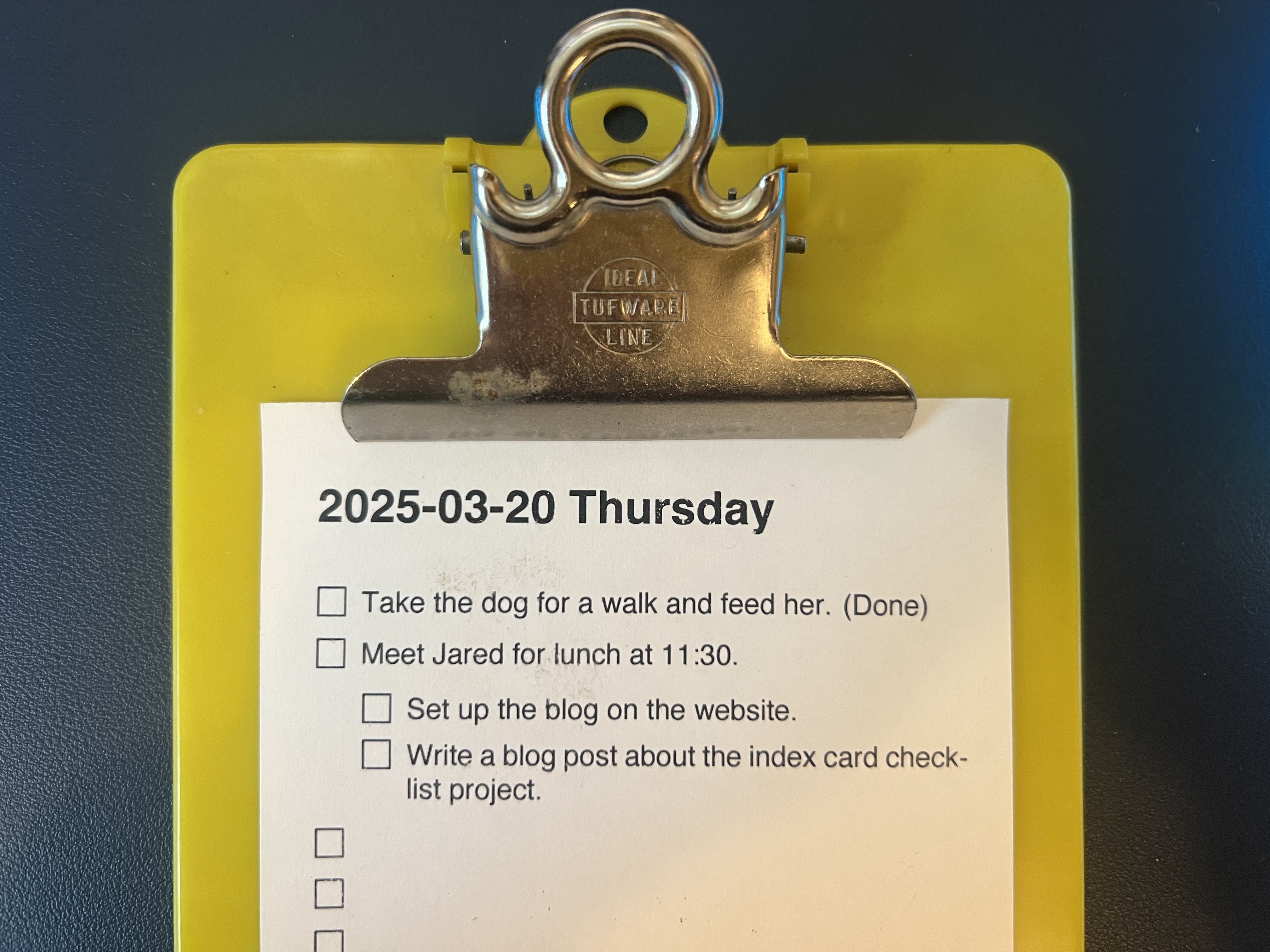
It’s satisfying to cross things off a paper checklist. A paper checklist can’t interrupt you. At the end of the day you can add it to a growing little stack on your desk and feel accomplished.
Printers are also amazing. Computer laid out text is neat and organized. A perfectly square checkbox feels authoritative.
I’ve been experimenting in earnest with ways to make an efficient pipeline for printing a daily agenda. This latest version finally got the pieces coming together.
My goals for this project are:
- Easy and streamlined. Don’t overthink it.
- Local to my devices– no external AI or tools.
- Purposeful and useful.
TL;DR
- Dictate my daily to-dos to Stardate.
- Format today’s Stardate notes from iCloud Drive with LLM.
- Slap it into a LaTeX template.
- Print to a 4x6 index card.
Format
I’ve experimented with receipt paper like the Little Printer, and I sure wish I could make that work well for my purposes. Ultimately I’ve decided this is more romantic than practical, and having a roll of paper to print on just begs for scope creep.
Index cards are great. Just enough space for a day’s intentions.
I’ve used 3x5 index cards for checklists before. When I discovered that my thrifted-and-indestructible Brother laser printer has a secret single sheet slot that supports a 4x6 card the solution seemed obvious.

Layout
Great, so we know we’re doing a 4x6 index card. How do we design for it?
I tried several things here and was left unsatisfied by most of them. Google Docs is a nightmare for small formats. Apple Pages can do it, but the checkboxes are hideous. Markdown would be an obvious choice for easy organization of text, but rendering seemed like a bit of a mess.
Then I remembered good ol’ LaTeX!
LaTeX is kind of perfect for this application.
- It can handle a complex layout with fine-grained control over the type.
- Similar to Markdown, the layout is done entirely in text. This makes copying items into a template easy, or even controlling it via a script.
- Unlike other markup languages like HTML, it’s designed to be rendered in a printed form. So doing things like making a 4x6 document is easy.
Also because it’s just text, LLMs are familiar with the structure and can help write it. I did just that and came up with this template in a few minutes of back and forth with ChatGPT. A fine start!
Input
I’m starting small here. Rather than try to connect a bunch of data sources together like my calendar or task management apps, I dictate a few notes to my app Stardate while I’m making breakfast. Usually I roughly know what I’m doing today (or what I want to do), so it’s better to think aloud than try to have something assembled for me.
Stardate takes voice notes from your Apple Watch or iPhone and transcribes them locally using Whisper for free. A lesser-known feature of Stardate is that all your notes are saved to your iCloud Drive as text files. This makes them super easy to grab today’s notes on the Mac. These files should live in the same place for everyone:
1 | ~/Library/Mobile\ Documents/iCloud~com~deanputney~Stardate/Documents/ |
There are two directories in here by default: Recordings and Transcriptions.
Grabbing the list of today’s files is easy:
1 | find Transcriptions -type f -name "*$(date +%Y-%m-%d)*" |
Normally I would do something like:
However, iCloud does not seem to fully respect the creation date for these files. If something is re-synced, it could have a creation date other than its actual recording time. Fortunately, the Stardate files all have their datetimes in their name.
If you know of a better approach, I’m interested.
Formatting
Now that we have the latest notes, we need to pull out tasks and make a list. I’m doing this using the LLM command line tool.
1 | find Transcriptions -type f -name "*$(date +%Y-%m-%d)*" | \ |
To break that down:
- Get the list of filenames.
- Read the text from each file.
- Feed through llm with a system prompt read from another file.
The LLM takes this input:
1 | Another thing I need to do, also finished, so I'd probably put |
…with this system prompt:
1 | You are processing a transcription entry to identify chechklist items. |
…and returns this output:
1 | - [x] Take the dog for a walk |
You might be thinking “hey, that’s Markdown, not LaTeX! J’accuse!`”
You would be right. In order to get LaTeX output I use this system prompt (saved as latex_checklist.md) instead:
1 | Given the following latex template, and the following checklist, |
…which outputs:
1 | \item Take the dog for a walk and feed her. (Done) |
Different LLMs have different results! My
llmis set to usegemma3:12blocally via Ollama by default. This is the first local LLM I’ve found that can handle the LaTeX formatting correctly.
llmcan use paid services like ChatGPT instead, but I like running this locally. I’m experimenting with gettingllama3.2:1bto return correct formatting for Markdown in hopes that I can run this on the phone later.
Printing
Finally, I copy this output to my LaTeX editor, add anything else I thought of, and print it to an index card. I bought a mini yellow clipboard at a thrift store to carry it with me.
Keeping this last part manual lets me tweak things if I need to. For example, I might add checkboxes for medication reminders to the template. Sometimes I might make a generic checklist instead of a daily agenda. Also the LLM output is not perfect, and might need fixing. The flexibility is helpful.
Thanks for reading! Check!